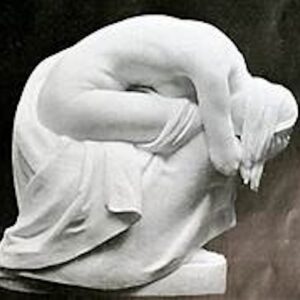- “The Impulse”
It was too lonely for her there, And too wild, And since there were but two of them, And no child, And work was little in the house, She was free, And followed where he furrowed field, Or felled tree.
She rested on a log and tossed The fresh chips, With a song only to herself On her lips. And once she went to break a bough Of black alder. She strayed so far she scarcely heard When he called her— And didn’t answer—didn’t speak— Or return. She stood, and then she ran and hid In the fern.
He never found her, though he looked Everywhere, And he asked at her mother’s house Was she there. Sudden and swift and light as that The ties gave, And he learned of finalities Besides the grave.
On the surface it is a story fit for a novel, or even a short story: A wife gets restless and ends a marriage.
Yet the “impulse” of the title is everything. The wife’s breaking of the branch echoes Dante’s breaking of a branch in Inferno’s Forest of the Suicides. This hints that the wife’s impulsive divorce—a finality “besides the grave”—is a kind of suicide, the marital bond slit like a wrist. Frost knew instinctively what psychiatry research has established: Most people who commit suicide think about it for ten minutes or less beforehand. It is an impulse.
The botany in this poem, as we might expect in a poet so attuned to the natural world, is crucial. The other plant mentioned is a fern. The spores hide under the frond. You turn them over and see them crowded there. Those spores themselves are waiting, self-contained.
The wife’s impulse, seemingly inexplicable on the first read, turns out be lurking throughout the poem. She sings “only to herself,” not to him, and not to a child. Why don’t they have one? In rural America at that time (Mountain Interval, the volume in which this poem appears, was published in 1916), in an era before birth control, a childless couple was more unusual than we realize today. What is missing from their relationship that accounts for that detail? When she tosses the fresh wood chips, she might be doing so out of idleness, or distraction, or sadness, or frustration. The reader, like the husband, goes back through the poem and sees warning signs. The husband, like the reader, should have seen it coming all along.
Just as Frost does not tell us why she is tossing those wood chips, he does not give us any description of the interior mental state of either husband or wife. Nor does he tell us where she went, or even if she is still alive, nor what the husband does after he is abandoned. These elisions, these suppressions of information, give the poem a power that a novel many thousands of times its word count would squander in detailed internal monologues and back stories. We know just enough to share the husband’s surprise and bafflement and slow, retrospective realization. This is an instance poetry where outdoes conventional prose fiction as a storytelling medium. The story could have been boring or commonplace. The telling rescues it and makes it immediate.
The word “impulse” is used very commonly in neurology. It is important to realize that neuroscience was advancing rapidly in the years before Frost—a lover of scientific literature—wrote the poem. Galvanometers, used to measure tiny electrical charges, were invented in 1820; in 1908, the Dutch physician William Einthoven used that machine on the human vagus nerve, electrifying the scientific community by quantifying neural impulses: the electricity that crackles through our neural networks, the physiology of thought and emotion.
These are the impulses at the essence of us: the Buddha knew them by the Pali word tanha, craving. Frost’s tone is calm and matter-of-fact, and his form is simple and ballad-like, but what he creates is a poem that resembles the impulse it portrays—erratic, electric, tragic, human.
- “Devotion”
The heart can think of no devotion Greater than being shore to ocean— Holding the curve of one position, Counting an endless repetition.
In this quatrain, Frost gets at the heart of devotion of every kind: Repetition.
Consider how often the devotion of parent for child takes the form of repetitive actions. It’s not just one diaper that needs changing, not just one spoonful of pureed sweet potatoes that needs to make it to the mouth (and chin, and bib).
Devotion to the divine, across religions, takes the form of repetitive actions. Repeated prayers, either before bed, or first thing in the morning, or five times a day, or in some monastic orders seven times a day. Rituals, like a Vedic sacrifice or a Mass or a wedding ceremony, gain power by staying identical to the ones before it. The Sanskrit word japa refers to a meditation practice that consists of focusing the mind by repeating one sacred word over and over.
Art, too, demands devotion. Practicing an instrument means playing a piece repeatedly until you get it right. Rehearsing a play works the same way. Poets revise and rewrite, and, if they work at a form, attempt sonnet after sonnet, or quatrain after quatrain, until they get one worth preserving. Both the verse line and upholding a tradition, too, take the form of repetition: Frost wrote this quatrain in the same iambic meter used by Shakespeare and Dickinson. The line itself is constructed of repetitions of a metrical foot. And let us not forget the poetic repetition that makes this poem intrinsically memorable—devotion, ocean, position, repetition—the musical again-and-again of rhyme.
Readerly devotion, too, takes the form of repetition: When you love a poem, you reread it many times, until you become one with the object of your devotion. The mantra-repeating mystic longs to become one with the divine; and the violinist with his cheek lovingly against the wood, as he plays the practiced piece by heart, becomes one with the violin. A poem becomes a part of your memory. You recite it, and the lines arrive as ever-familiar waves against the coast of you. You are reshaped, revealed—and somehow, by this poetic process of erosion, restored.
Amit Majmudar is a poet, novelist, essayist, and translator as well as a diagnostic and nuclear radiologist. The former first Poet Laureate of Ohio, he lives in Westerville, Ohio with his wife and three children. Twin A: A Memoir is available from Slant Books, and his forthcoming book of literary essays is entitled The Great Game: Essays on Poetics.





